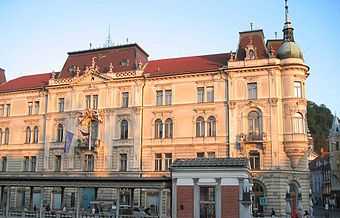Kresija Palace


The Kresija Palace (Slovene: Kresija) is a building that together with Philip Mansion marks the entrance to the old town of Ljubljana, the capital of Slovenia.[1] It is located on Adamič Lunder Embankment (Adamič–Lundrovo nabrežje) on the right bank of the Ljubljanica River immediately after the Triple Bridge and borders Pogačar Square (Pogačarjev trg), Stritar Street (Stritarjeva ulica), and Maček Street (Mačkova ulica).[2] Until 2007, the Ljubljana Center Administrative Unit was stationed in the building.[3] Now, it houses a number of municipal offices, the Kresija Gallery, and the Ljubljana visitor centre.[4][5]
The building has an irregular square plan and an inner court.[6] It is noted for its Neoclassical façades and interior.[6] The decoration resembles of the Baroque.[1] It was designed by the Graz architect Leopold Theyer and erected in 1897 and 1898, after the Ljubljana earthquake in 1895.[6] The name of the palace comes from the German word Kreisamt, referring to the district office of Ljubljana. Before the earthquake, there was a building of a hospital and a school at the place.[5] At the first floor, the district office was stationed in the first half of the 19th century.[7] Next to it stood St. Elizabeth's Church until 1831.[8]
References
- ↑ 1.0 1.1 "Filipov dvorec in Kresija" [Philip Mansion and Kresija]. Arhitekturni vodnik [Architectural Guide] (in Slovene). Zavod Trajekt. Retrieved 28 May 2012.
- ↑ "5595: Ljubljana - Kresija" [5595: Ljubljana – Kresija]. Register nepremične kulturne dediščine [Registry of Immovable Cultural Heritage] (in Slovene). Ministrstvo za kulturo Republike Slovenije. Retrieved 29 February 2012.
- ↑ "Za Kresijo na mestu še nimajo novih načrtov" [The Town Has no Plans for Kresija Yet]. Dnevnik.si (in Slovene). 14 November 2011.
- ↑ Dobnik, Jože (2006). "Točka Ljubljana" [Point: Ljubljana]. Pot kurirjev in vezistov NOV Slovenije [Path of Couriers and Operators of the National Liberation War of Slovenia] (in Slovene). Društvo Domicilnega odbora kurirjev in vezistov NOV Slovenije. ISBN 961-238-581-5. Retrieved 28 May 2012.
- ↑ 5.0 5.1 "Kresija – stanovska latinska šola – Adam Bohorič – protestantsko šolstvo" [Kresija – Protestant Estates' Latin School – Adam Bohorič – Protestant Education]. Sprehod po poti kulturne dediščine šolstva v Ljubljani [A Walk Along the Path of the Cultural Heritage of Education in Ljubljana. Slovenian School Museum. Retrieved 28 May 2012.
- ↑ 6.0 6.1 6.2 Lutman, Marjana. "Kresija". In Šmid Hribar, Mateja; Golež, Gregor; Podjed, Dan; Kladnik, Drago; Erhartič, Bojan; Pavlin, Primož; Ines, Jerele. Enciklopedija naravne in kulturne dediščine na Slovenskem – DEDI [Encyclopedia of Natural and Cultural Heritage in Slovenia] (in Slovene). Retrieved 28 May 2012.
- ↑ Andrejka, R. (19 April 1935). "Ljubljanske ulice, ki so izginile" [Streets of Ljubljana that Have Disappeared]. Slovenec: političen list za slovenski narod 62 (91a) (Ljudska tiskarna). ISSN 1408-2381.
- ↑ Stare, Vida (1991). "Pokopališče pri sv. Elizabeti v Špitalski ulici v Ljubljani" [The Cemetery at St. Elizabeth's Church in Hospital Street in Ljubljana]. Kronika: časopis za slovensko krajevno zgodovino [The Chronicle: the Newspaper for the Slovenian History of Places] (in Slovene) (Association of Slovenian Historical Societies, Section for the History of Places) 39 (3). ISSN 0023-4923.
See also
| Wikimedia Commons has media related to Kresija Palace. |
- Center (Ljubljana)
Coordinates: 46°3′3.64″N 14°30′24.52″E / 46.0510111°N 14.5068111°E